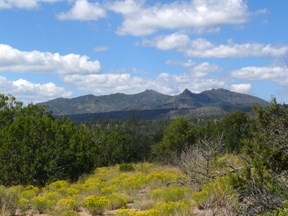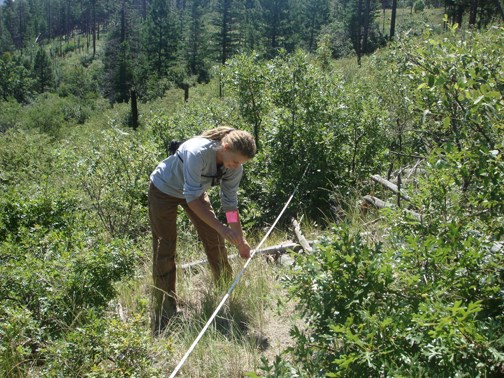
Bandelier National Monument sits at the southern end of the Pajarito (Spanish for little bird) Plateau. The plateau was formed by two eruptions 1.6 and 1.4 million years ago. Home to the Bandelier Wilderness, Bandelier ranges from 5340 ft at the Rio Grande to the south and 10199 ft at the summit of Cerro Grande to the north, almost a mile of elevation change in just under 12 miles. This elevation gradient creates a unique diversity of habitats specific to Northern New Mexico. The diversity of habitats and quick access to water supported a relatively large population of Ancestral Pueblo people. Currently, Piñon-Juniper woodlands dominate in the southern parts of the park transitioning through ponderosa pine savannahs and forests finally reaching mixed conifer forests at the highest elevation. Scattered throughout the park are desert grasslands, montane meadows, and riparian areas in the canyon bottoms. Bandelier is home to a wide variety of wildlife. The backcountry trails at Bandelier climb in and out of deep canyons and cross large flat mesas, showcasing the entire spectrum of volcanic geology. A large portion of the northeastern boundary is shared with Los Alamos National Lab, which covers 26,500 acres of restricted, mostly open space. Bandelier's direct neighbors make the park's 34,000 acres feel much larger than it is. 
Scientific Research in the Natural SciencesEven though Bandelier is modest in size when compared to the flagship national parks, scientists here are working hard to have the same output as some of the largest parks. Cultural Science research has been done in Bandelier for more than a century starting the writings of Adolph Bandelier, and in recent decades natural science research has gained equal footing.
Learn more about research currently underway at the park A portion of the ecological research done at Bandelier comes from the Western Mountain Initiative. The Western Mountain Initiative (WMI), part of the USGS Global Change research program, seeks to understand and predict the responses of mountain ecosystems to climate variability and accordingly shape land management strategies. The USGS Jemez Mountain Field Station at Bandelier plays an active role in gathering and analyzing data to further understand the complex responses of mountain ecosystems to climate changes. The USGS and the Park Service combine efforts at Bandelier to form the Ecology Group. This group has developed large, regional-scale networks of long-term ecological monitoring and global change research. This research has promoted cross-boundary collaborations with numerous federal, state, local and non-profit public institutions working toward integration of science with resource management. Ultimately leading to a place-based approach where scientists interact on-site with managers on a regular basis, providing effective communication, application and follow-through on relevant management issues. |
Last updated: April 28, 2025
